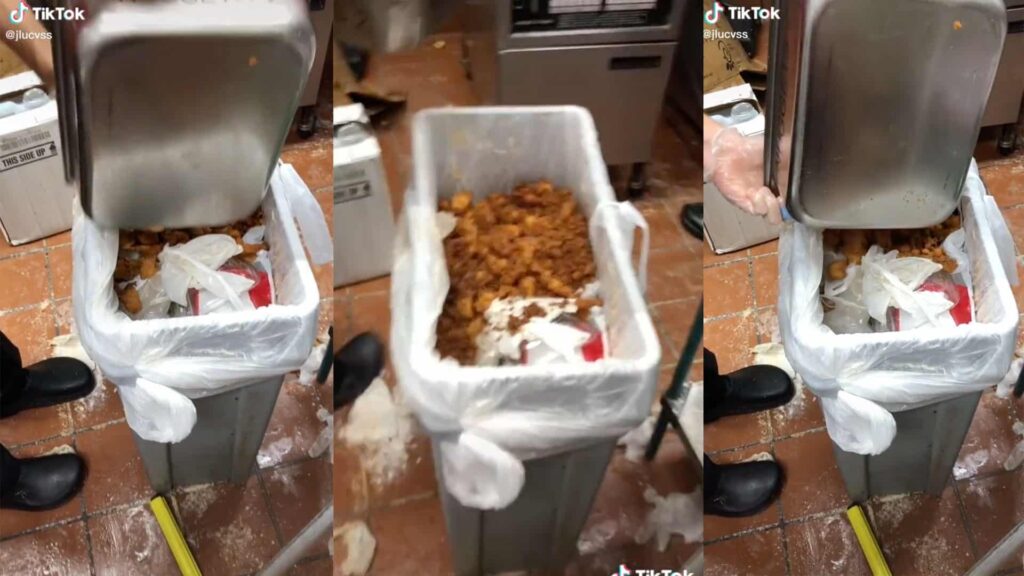A viral Tik Tok of a Chick-fil-A worker throwing out excess nuggets shocks the internet and highlights the United States’ problem with food waste.
https://www.tiktok.com/@jlucvss/video/6965345313393691910?referer_url=https%3A%2F%2Fwww.dailydot.com%2F&referer_video_id=6965345313393691910&refer=embed&is_copy_url=1&is_from_webapp=v1
The video shows a Chick-fil-A worker dumping a packed container of chicken nuggets into the garbage. The clip has amassed 7.5 million views with a comment section that one could read for hours. The caption reads, “What they do every night with the chicken nuggets at Chick-fil-a”. The comment section was filled with people chiming in. One of the most liked comments said, “The amount of food we throw away, and the amount of starving people there are just doesn’t sit right with me”. The truth is, food waste is more common than anyone would like to think, and restaurants throw out more food than most would imagine. Average households waste about 32 percent of their food, while restaurants waste almost thirty million pounds of food per year. Food waste is piling up in our homes, restaurants, and landfills. Production needs to decelerate to help combat the dangerous environmental effects.
The popular video from Chick-fil-A has highlighted the fact that food waste takes up more space in US landfills than anything else. There are several reasons for this, including the amount of waste within families, corporations, and restaurants. Another major contributor to food waste is the misleading labeling of consumer products in grocery stores. Consumers tend to be confused by the similarities in stamping and are not aware of the differences between sell by, best by, and use by. This spreading of misinformation has caused 80 percent of Americans to throw out “spoiled food” that most of which has only perceived spoilage.
Sell By dates refers to a label for retailers for the optimal date to have the product removed off the shelf. This does not mean that the product will go bad by then, as the product usually has ⅓ of its shelf life left.
Best By dates refers to a suggestion for the consumer for optimal quality and presentation.
ADVERTISEMENT
Use By dates refers to the last date recommended for use of the product at its peak quality. It generally is not associated with a safety date.
The USDA even states that “the quality of perishable products may deteriorate after the use-by date passes but, the products should still be wholesome if not exhibiting signs of spoilage”. Globally, 1.4 tons of food are wasted every year, and yet, there are 957 million people across 93 countries who do not have enough to eat.

The United States is the world’s leader in food waste, and it negatively impacts our environment more and more each day. According to Vox News, about forty percent of food produced in the United States never gets eaten. This also means that forty percent of the energy and resources used to make that food is used for nothing. According to the World Wildlife Federation, the production of wasted food in the US is equivalent to the greenhouse emissions of 37 million cars. Furthermore, rotting food waste is one of the largest producers of greenhouse gases, which is the main contributor to climate change. Therefore by solving the food waste problem in the U.S there would be stark changes in the difference in greenhouse gases emitted by both the production and spoilage of food. Simultaneously to this occurrence, one in eight Americans do not have a steady supply of food to their tables.
How To Help
To enact meaningful progress in combating climate change, there needs to be the implementation of green solutions on a grandeur level, including cooperation with major companies. However, to be more mindful about food waste, there are many changes that can make a difference.
In households, composting can be implemented to create fertile soil and keep vegetable waste out of landfills. This combined with mindfulness about personal waste can make a difference, even if it’s only in how much waste is made in your own home.
ADVERTISEMENT

In restaurants, business owners can get connected with apps like Food For All and Too Good to Go. These apps sell discounted meals at the end of the night, so there is less food waste. There is also a list of 16 food apps that help reduce food waste by either connecting donors with charities or providing surplus foods at a discount.
Lastly, on a larger scale, there can be legislation or institutionalized ways to help combat food waste in the US. In Vermont, the “Universal Recycling Law” went into effect in July 2020. This law banned food scrap waste entirely, and has resulted in a forty percent increase in food donations state-wide.
The United States should also look at what other countries have done to reduce their harmful food waste. France requires all restaurants to donate food (that is still safe to eat) before throwing it out. Sweden has a system where certain cities use their food waste to power the public bus systems.

Whether the food is donated to homeless shelters, given to food pantries, sold at a discounted price, or used for fertile soil, anything is better than sitting in a landfill for the foreseeable future emanating toxic greenhouse gases that are killing our planet and soon, our people. Greenhouse gases negatively affect the environment, and as carbon dioxide emissions rise, they also negatively impact humans. Save the planet, save yourself, and be mindful of food waste because there are solutions.









